

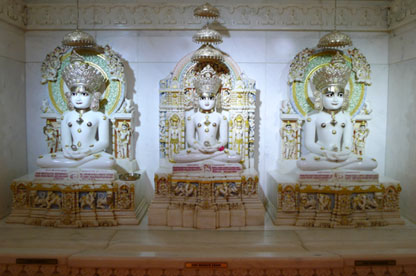
The Second Floor of the JCA NY Temple is 4,000 Sq. Ft. and consists of the Shri Mahavir Swami Temple in the Shwetambar tradition and a large Upashraya/Sthanak in the Sthanakvasi tradition. The Shri Mahavir Swami Temple has a Main Garbha Griha with Ghummat, Kalash & Dhwaja. The Mulnayak Pratimaji, Shri Mahavir Swami , is 21”, with a 25” Shri Neminathji on the right and a 25” Shri Sambhavnathji on the left side, all of white marble. In the back Gabhara, inside the Gokhalas, on the rear right side, is the 31” Pratimaji of Shri Parshwanathji in black marble and on the rear left side is the 31” Panch Dhatu Pratimaji of Shri Shantinathji. The Bhamati Parikrama is graced by an 81” Jaisalmer light brown Shri Adinathji Choumukhi. The east and west walls are graced by the idols of Shri Simandhar Swami, Shri Gautam Swami and eight other idols of Dev and Devi all made of white marble. There are many beautiful carved marble columns and arches as well as exquisite marble Pat and paintings on the walls of
the temple, as well as chandan & shower rooms.
The Svetambara (also spelt Svetambar, Shvetambara, Shvetambar or Swetambar) is one of the two main sects of Jainism, the other being Digambar. Svetambar literally means "white-clad", describing its ascetics' practice of wearing white clothes, which sets it apart from Digambar ("sky clad"), whose ascetic practitioners wear no clothes. Svetambaras, unlike Digambaras, do not believe that ascetics must practice nudity, or that women are unable to obtain moksha. Svetambaras maintain that the 19th Tirthankara, Mallinath, was a woman. At present in Svetambara sects, there are 2,510 Monks and 10,228 nuns, while in Digambaras there are 548 monks and 527 nuns (According to 'Smagra Jain chaturmas suchi-2006'). The Svetambara tradition follows the lineage of Acharya Sthulibhadra suri. Kalpasutra mentions some of the lineages in ancient times, from the Kottiya Gana, which was once prominent. The Svetambara monastic orders are branches of Vrahada-gachchha founded in 937 AD. The most prominent among the classical orders today are Kharatara-gachchha (1024 AD), Tapa Gachchha (1228 AD) and Tristutik Gachchha. A major dispute was initiated by Lonka Shaha, who started a movement opposed to idol worship in 1476. The Sthanakvasi and Terapanthi (Svetambara) (1780) orders are branches of this movement. The major reforms by Vijayananda Suri (1827 - 1906) in 1880, as the leader of the Tapa Gachchha, led a movement to restore orders of wandering monks, which brought about the near extinction of the Yati institutions. Acharya Rajendrasuri restored shraman sanstha in the "Tristutik" gachchha. Some Svetambara monks and nuns cover their mouth with a white cloth (muhpatti) to practice ahimsa even when they talk and by doing so they minimize the possibility of inhaling small organisms.
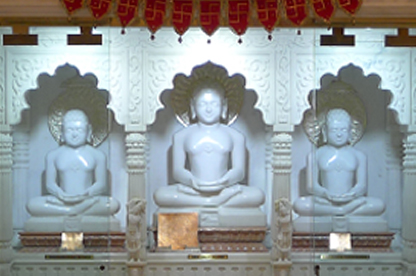
The Third Floor of the JCA NY Temple is 3,800 Sq. Ft. and consists of the Sri Adinathji Temple in the Digambar tradition, Shrimad Rajchandra Meditation Hall, and a Library. The Shri Adinathji Temple has a Main Garbha Griha with Three Shikhars, Kalash & Dhwaja. The Mulnayak Pratimaji is 31” Shri Adinathji Swami, with a 25” Shri Padma Prabhuji on the right and a 25” Shri Chandra Prabhuji on the left side, all of white marble. Inside the Gokhalas, on the right side, is the standing 51” Pratimaji of Shri Parshwanathji in black marble and on the left side is the standing 51” Pratimaji of Shri Bahubaliji of pink marble. Two Gokhalas contain smaller Pratimas of Shri Mahavir Swami in white marble and a Panch Dhatu Pratimaji of Shri Shantinath Swami. The other Gokhalas contain Jinvani Books, and picture of Acharyas. All five Pratimaji’s were consecrated in a Panch Kalyanak Puja at Agra, India in Feburary 2004. There are many beautiful carved marble columns and arches as well as numerous exquisite marble Pat and paintings on the walls of the temple.
The name Digambar means literally 'clothed in the quarters of the sky' and they are called 'sky-clad.' Nudity is the main doctrinal difference between the Shvetambaras and the Digambaras. The Digambara view on ascetic nakedness was put by Aparajita in the eighth century. The true monk must be completely naked; even a loincloth is a compromise. He must abandon all possessions and be no longer subject to the social considerations of pride and shame and to obey the vow of ahimsa, non-violence. The naked monk must follow the example of the Jinas, who were naked. As well, he may not use an alms-bowl, but has to use his hands cupped together as a bowl. He can eat only once a day.
There are doctrinal differences with the Shvetambaras over the Jinas. The Digambaras believe that kevalins, perfect saints, such as the Jinas live without food. In fact, the Jina can manifest no worldly activity and no longer has any bodily functions, for if he did his jiva, soul, would then change and he would not be omniscient. The Jinas teach by a magical divine sound. There are also differing accounts of the life of Mahavira. To the Digambaras, the embryo of Mahavira was not removed from the womb of Devananda to that of Trisala, as the Shvetambaras believe, and they do not follow the Shvetambara account of Mahavira being married and living the life of the householder until he was thirty.
In the Digambara tradition, women cannot gain moksha, liberation, unless they are first reborn as men.
The Digambaras disown the Shvetambara canon, claiming that these texts were gradually lost during the first centuries after the Nirvana, death, of Mahavira. They give canonical status to two Prakrit works, Chapters on Karman and Chapters on Kasayas (Passion), both of which they claim were composed on the basis of the lost Drstivada. Of great importance to the Digambaras are the works of Kundakunda, such as Essence of the Doctrine. Essentially, the difference in doctrine is minor. Both the Shvetambara and Digambara traditions accept the Tattvarthasutra of Umasvati, who in the second century was the first systematized of Jain philosophy.
The philosophy and ethics which form the foundation of Jainism are exactly the same for both the Shvetambaras and the Digambaras, and the five major vows of ahimsa, non-violence, satya, truth, asteya, non stealing, aparigraha, non-possession, and brahmacarya, celibacy, are central to their doctrine.
Most Digambaras are image-worshippers, except for the sects of the Terapanthis (Terahapanthis) and the Taranapanthis. Gumanapanthis and Totapanthis are minor subsects of the Digambaras. They are not very important and very little is known about them. Gumanapantha flourished late in the eighteenth century and is named after its founder Gumana Rama. In History, there are both Shvetambara and Digambara stories of the origin of the Digambara sect. The Shvetambara version says the sect started 609 years after the death of Mahavira when a Shvetambara named Shivabhuti initiated himself as a monk after he was angry at being locked out one night by his mother-in-law and subsequently decided to follow the way of Mahavira and threw off his monastic robes. The Digambara version is set in the time of durbhiksha, 'a time when it is difficult to gain alms,' when there was famine and political anarchy in the North. The Digambaras migrated to the South under Bhadrabahu, while those that remained became the backsliding Shvetambaras who took to wearing clothes. The Shvetambaras maintain that Bhadrabahu was at that time in Nepal. Neither version is very old, the Shvetambara story dating from the fifth century CE and the Digambara story from the tenth century CE.
The actual historical situation is more complex. It is likely that the fracture into two major sub-groups on the basis of clothing or nudity took place gradually, judging from archaeological and inscriptional evidence. There was no sudden doctrinal split. Mahavira and his followers were naked monks and the earliest Jina-images are naked. Only in the fifth century CE is there an image of Rishabha wearing a lower garment. Shvetambara images became generally clothed only several centuries later. The name Digambara took some time to become established in use. Until the fourteenth century a sect called the Yapaniyas existed, which shows the original flexibility regarding sectarian affiliation. Yapaniyas were a compromise, wearing clothes only when with lay followers.
The schism appears to have been recognised as early as the first century CE and was certainly established by the time of the Council of Valabhi in 453 or 466 CE. Dundas describes the Council as "The catalyst for the final hardening of boundaries between the Shvetambaras and the Digambaras" (1992, 43). Only Shvetambaras came to the Council, held on the Kathiawar Peninsula.
Geography played an important part in the schism, with the Digambaras prospering in South India and the Shvetambaras remaining mainly in the North. The Digambaras claim that when they migrated south with Bhadrabahu to Mysore, Candragupta Maurya, first king of the Maurya dynasty who had become a Jain monk, was with them. They believe that Bhadrabahu and Candragupta Maurya died the holy death of sallekhana, fasting to death, on hills at Sravana Belgola. There is no evidence of this, but numerous inscriptions in the area from the fifth century CE support a southern migration.
The Digambaras must have held an important position in South India in the early centuries CE. Jain influence is apparent in Dravidian literature, as in the Tamil epic Silapadikkaram, 'Lay of the Anklet.' The Digambaras have an extensive literature of their own, chiefly in Sanskrit, which has a greater antiquity than that of the Shvetambaras, with the exception of the canonical texts of the Shvetambaras. There was often a close relationship between Digambara monks and kings. In 981 the giant statue of Bahubali was erected at Sravana Belgola in Karnataka by Camundaraya, a general of a king of the Ganga dynasty. The twelth century Hoysala dynasty supposedly originated through the influence of a Digambara monk. There was a powerful ideal of the righteous Jain king.
In the medieval period the Digambara ascetic community split into various sects. The Mula Sangha, the 'Root Assembly,' descended from Mahavira through Kundakunda, split into four sections called Sena, Deva, Simha, and Nandin. Then there were rival Digambara sects such as the Dravida Sangha at Madurai which allowed bathing.
The main figure in medieval Digambara Jainism was the bhattaraka, meaning 'learned man' but who in fact was the head of a group of monks in a matha, monastery, who wore orange robes except when eating or initiating another bhattaraka. Some bhattarakas became king-like figures and there were thirty-six bhattaraka thrones around India. They helped to perpetuate Digambara Jainism. A Rajasthan bhattaraka in the fifteenth century consecrated a thousand Jina-images to send all over India to replace those destroyed by the Muslims. With the Hindu Renaissance, Jainism in South India went into retreat.
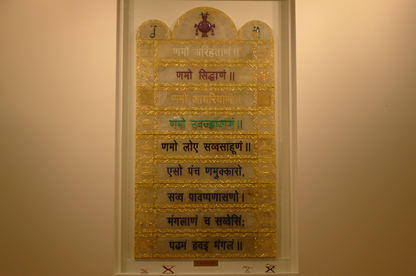
The Upashray Lecture Hall, on the second floor of the JCA NY Temple, has space for about 200 people and provisions for audio-visual facilities and opens up via a folding partition to the Mahavir Swami Temple. The Upashraya is having a Navkar Mantra placed on the East Wall (Navkar Niche). The size of the Navkar Mantra is 4’x6’ and carved in crystal stone with colored gem stone inlay in the original color of each line of the mantra. There are many beautiful carved marble columns and arches as well as exquisite marble Pat and paintings on the walls of the temple, as well as chandan & shower rooms.
The Sthanakvasi arose not directly from the Svetambaras but as reformers of an older reforming sect, viz., the Lonka sect of Jainism. This Lonka sect was founded in about 1474 A.D. by Lonkashaha, a rich and well-read merchant
of Ahmedabad. The main principle of this sect was not to practice idol-worship. Later on, some of the members of the Lonka sect disapproved of the ways of life of their ascetics, declaring that they lived less strictly than Mahavira would have wished. A Lonka sect layman, Viraji of Surat, received initiation as a Yati, i.e., an ascetic, and won great admiration on account of the strictness of his life. Many people of the Lonka sect joined this reformer and they took the name of Sthanakvasi, meaning those who do not have their religious activities in temples but carry on their religious duties in places known as Sthanakas which are like prayer-halls.
The Sthanakvasi are also called by terms as (a) Dhundhiya (searchers) and (b) Sadhumargi (followers of Sadhus, i.e., ascetics). Except on the crucial point of idol-worship, Sthanakvasi do not differ much from other Svetambara Jainas and hence now-a-days they invariably call themselves as Svetambara Sthanakvasi. However, there are some differences between the Sthanakvasi; and the Murtipujaka Svetambaras in the observance of some religious practices. The Sthanakvasi do not believe in idol-worship at all. As such they do not have temples but only sthanakas, that is, prayer halls, where they carry on their religious fasts, festivals, practices, prayers, discourses, etc. Further, the ascetics of Sthanakvasi cover their mouths with strips of cloth for all the time and they do not use the cloth of yellow or any other color (of course, except white). Moreover, the Sthanakvasi admit the authenticity of only 31 of the scriptures of Svetambaras. Furthermore, the Sthanakvasi do not have faith in the places of pilgrimage and do not participate in the religious festivals of Murtipujaka Svetambaras.
The Svetambara Sthanakvasi are also spread in different business centers in India but they are found mainly in Gujarat, Punjab, Harayana and Rajasthan.
It is interesting to note that the two non-idolatrous sub-sects, viz., Taranapanthis among the Digambaras and Sthanakvasi among the Svetambaras, came very late in the history of the Jaina Church and to some extent it can safely be said that the Mohammedan influence on the religious mind of India was greatly responsible for their rise. In this connection Mrs. S. Stevenson observes: "If one effect of the Mohammedan conquest, however, was to drive many of the Jainas into closer union with their fellow idol-worshippers in the face of iconoclasts. Another effect was to drive others away from idolatry altogether. No oriental could hear a fellow oriental’s passionate outcry against idolatry without doubts as to the righteousness of the practice entering his mind, Naturally enough it is in Ahmedabad, the city of Gujarat, that was most under Mohammedan influence, that we can first trace the stirring of these doubts. About 1474 A.D. the Lonka sect, the first of the non-idolatrous Jaina sects, arose and was followed by the Dhundhiya or Sthanakvasi sect about 1653 A.D. dates which coincide strikingly with the Lutheran and Puritan movements in Europe." (vide Heart of Jainism, p. 19).
The terapanthi sub-sect is derived from the Sthanakvasi; section. The Terapanthi sub-sect was founded by Swami Bhikkanaji Maharaj. Swami Bhikkanaji was formerly a Sthanakvasi saint and had initiation from his Guru, by name Acharya Raghunatha. Swami Bhikkanaji had differences with his Guru on several aspects of religious practices of Sthanakvasi ascetics and when these took a serious turn, he founded Terapantha on the full-moon day in the month of Asadha in the year V.S. 1817, i.e., 1760 A.D.
As Acharya Bh1kkanaji laid stress on the 13 religious principles, namely, (i) five Mahavratas (great vows), (ii) five samitis (regulations) and (iii) three Guptis (controls or restraints), his sub-sect was known as the Tera (meaning thirteen)-pantha sub-sect. In this connection it is interesting to note that two other interpretations have been given for the use of the term Terapantha for the sub-sect. According to one account, it is mentioned that as there were only 13 monks and 13 laymen in the pantha when it was founded, it was called as Tera(meaning thirteen)-pantha. Sometimes another interpretation of the term Terapantha is given by its followers. Tera means yours and pantha means path; in other words, it means, "Oh! Lord Mahavira! it is Thy path".
The Terapanthis are non-idolatrous and are very finely organized under the complete direction of one Acharya, that is, religious head. In its history of little more than 200 years, the Terapantha had a succession of only 9 Acharyas from the founder Acharya Bhikkanaji as the First Acharya to the present Acharya Tulasi as the 9th Acharya.
This practice of regulating the entire Pantha by one Acharya only has become a characteristic feature of the Terapantha and an example for emulation by other Panthas. It is noteworthy that all monks and nuns of the Terapantha scrupulously follow the orders of their Acharya, preach under his guidance and carry out all religious activities in accordance with his instructions. Further, the Terapantha regularly observes a remarkable festival known as Maryada Mahotasava. This distinctive festival is celebrated every year on the 7th day of the bright half of the month of Magha when all ascetics and lay disciples, male and female, meet together at one predetermined place and discuss the various problems of Terapanthis.
The penance of Terapanthis is considered to be very severe. The dress of Terapanthi monks and nuns is akin to that of Sthanakvasi monks and nuns. But there is a difference in the length of muhapatti, i.e., a piece of white cloth kept always on the mouth. The Terapanthis believe that idolatry does not provide deliverance and attach importance to the practice of meditation.
Further, it may be stressed that the Terapantha is known for its disciplined organization characterized by one Acharya (i.e., religious head), one code of conduct and one line of thought. The Terapanthis are considered reformists as they emphasize simplicity in religion. For example, the Terapanthis do not even construct monasteries for their monks, who inhabit a part of the house which the householders build for themselves. Recently their religious head, Acharya Tulasi, had started the Anuvrata Andolana, that is, the small vow movement. which attempts to utilize the spiritual doctrines of the Jainas for moral uplift of the masses in India.
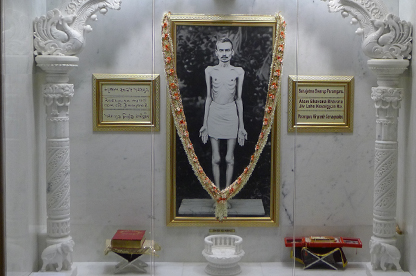
The Shrimad Rajchandra Meditation Hall has facilities for Samyak, Pratikraman, Bhakti & Sadhana. Inside a 60” x 30” marble structure is a Chitrapat of Shrimad Rajchandra along with a 7” Charan (Paduka), an “Aum” and an Idol of Mahavir Swami at the top. It has a folding partition with the Library, which contains an expanding collection of books and Shastras on Jainism, and a fully equipped JCA Manager and Administrative Office.
Shrimad was born to Smt. Devba and Shri Ravjibhai on the auspicious day of 9th November, 1867 (Kartik Purnima V.S. 1924), at Vavania (Gujarat, India). At the young age of 7, on witnessing the burning pyre of an acquaintance, He underwent unprecedented mental churning and attained Jatismaran jnan (a recollection of several past lives) at the cremation ground itself. This vivid recollection of the past, established continuity with His previously attained
state of knowledge, meditation and penance. As a result of this purification of His consciousness, many unusual mnemonic and psychic powers manifested in Him, but He chose to ignore them, focusing solely on self-realization.
Though young in age, He was spiritually mature, and remained in a state of heightened awareness. Despite a powerful intrinsic attitude of detachment and a burning desire for total renunciation, at the age of 20, He had to tie the knot of marriage and engage in business. Having spent nearly a decade of His life as a householder, ably discharging the responsibilities that had come His way, inwardly He remained completely detached. Worldly pleasures failed to attract Him in the least and He spent long hours in profound contemplation and deep meditation.
Ceaselessly immersed in spiritual pursuits, at the age of 23, He attained Shuddha Samyakdarshan (right self-perception). After the age of 28, His responsibilities decreased and He began to spend 4 to 6 months of the year in seclusion at various places in Gujarat, where He lived the life of an ascetic, taking very little food only once a day.
At the age of 32, He was at the threshold of complete renunciation when He contracted an illness from which He never recovered. Inspite of extreme physical discomfort, He always remained in a blissful state. Despite comprehensive treatment by doctors and meticulous care by devotees and relatives, all efforts to save His holy body failed. On 9th April, 1901 (Chaitra Vad Pancham V.S. 1957), at Rajkot, this enlightened soul left His mortal body, in a state of complete awareness.
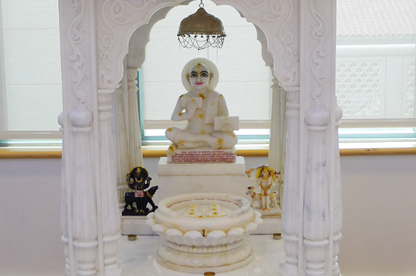
The Fourth Floor of the JCA NY Temple is 3,800 Sq. Ft. and consists of the Dadawadi Temple, The Asthapad Maha Tirth and the Dining Hall. The Dadawadi Temple contains a 15” Pratima of Shri Jin Kushal Suri Ji Maharaj and a 7” Charan installed in a white marble shrine open on all four sides under a canopy of skylight. In front of the Dadawadi Temple is a Roof Garden and the main Shikhar.
Dadawadi are the temples for Shwetambar Jains. These are the Temples dedicated to four Gurus of Kharatagach sect of Shwetambar Jains. There are many Dadawadis across India, like Malpura, Mehruali (Delhi), Ajmer, Bilada (Jodhpur). The idols are worshipped as Dada Gurudev. The Dadawadi at Malpura is the most visited one among all. Here the Gurudev Jin Kushal Suri ji give his sight to his follower on a stone and it still have its footprint on that
stone. Gurudev passed away in Deraur (now in Pakistan) before that he was in Malpura (Rajasthan) and there he was having many followers, after hearing the sad news of his demise one of his follower can’t believe the news and he sat on ground with a three days fast, praying that he wants Gurudev to give him his sight. After three days of his wait Kushal Guru give him his sight and told him that now he is no more. The stone on which he give the man his sight still have the footmarks of Gurudev and is largely followed by the peoples including non Jains too. The Dadawadi here comprises a big Dadawadi with a huge temple.
The Dadawadi in Delhi commonly known as Mehaurali Dadawadi is the place of Manidhari Dada Gurudev. When he knew that he would not live much longer, he told his followers that when he died a Mani would pop out of his head and any person holding a bowl of milk in his hand will get that Mani and also that while taking his body for the funeral the body should be kept where it was because his body should not move once it is earthed. When he died then everybody was so sad that they forgot the Gurudev sayings but a Muslim fakir remembered that and he kept a "Darshan" as he was also a big follower of Gurudev and the people set his body on ground for the purpose but as before stated the body didn't move, even elephants were used to move the body but all attempts were failed and the funeral was taken at that place, now known as Mehaurali Dadawadi. It's a very beautiful and big Dadawadi having a very beautiful glass temple and it also have a small creation of Shri Sammet Shikhar ji Tirth.